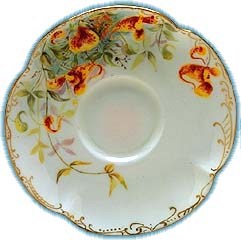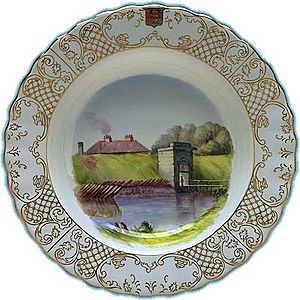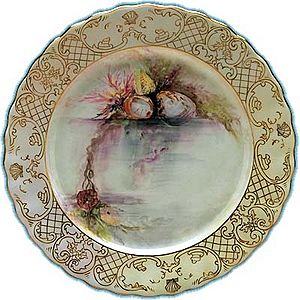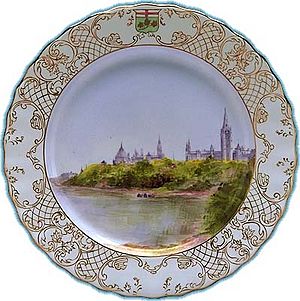Canadian Historical Dinner Service facts for kids
Quick facts for kids Canadian Historical Dinner Service |
|
|---|---|

Coffee cup saucer – Jewel-weed
Anna Lucy Kelley (1849–1920) |
|
| Artist | Alice Egan, Lily Osman Adams, Phoebe Amelia Watson and others |
| Year | 1897 |
| Type | Dinner service |
| Medium | Painted ceramics |
| Subject | Canada |
| Dimensions | 24 place settings for eight courses |
| Owner | National Trust for Scotland, Edinburgh |
The Canadian Historical Dinner Service is a special set of 204 pieces of hand-painted porcelain. It was made in 1896–97 to celebrate a big event: the 400th anniversary of John Cabot's first visit to Canada. This beautiful dinner service has 24 place settings, enough for eight different courses! Every single piece is unique, showing different Canadian scenes, animals, and plants.
Contents
Why Was This Dinner Service Made?
In 1896, the Woman's Art Association of Canada (WAAC) decided to create a special dinner service. They wanted Canadian women artists to paint it. This set would be used for important state dinners.
The WAAC formed a special group called the Ceramic Committee. This committee gathered many photos and drawings. They collected pictures of old forts, famous battlefields, and other historical places in Canada. They also found pictures of Canadian animals, fish, shells, ferns, and flowers.
The WAAC held a competition to choose the best Canadian ceramic artists. The work was then given to artists based on their skills. For example, some were better at painting birds, others at landscapes. The goal was to have artists from every Canadian province. However, the chosen artists were mainly from Ontario, Quebec, and Nova Scotia. Eight of them were from Toronto.
Mary Ella Dignam was the first president of the WAAC. She was the main person who made this dinner service happen. She oversaw the work of artists like Alice Egan, Lily Osman Adams, and Phoebe Amelia Watson.
The artists used high-quality china pieces from Doulton & Co. in England. Sir Henry Doulton himself was very interested in the project. He sent the best china blanks (plain pieces ready for painting) to the artists. The artists worked independently, painting the specific plates or cups they were assigned. The whole dinner service was finished and approved by July 7, 1897.
What Kinds of Plates Are There?
All the plates in the service are made of fine bone china from Doulton & Co. in England. There are 24 plates of each type. Most of the plates have wavy edges and a fancy gold border design.
Soup Plates
The soup plates have a shallow bowl. Each one is decorated with a historic Canadian landscape. The border of each plate also shows the special shield (heraldic shield) of the province featured in the painting. Clara Elizabeth Galbreaith and Phoebe Amelia Watson each painted twelve of these soup plates.
Fish Plates
The fish plates show different Canadian freshwater and saltwater fish. They also feature shells and seaweeds. Lily Osman Adams painted eighteen of these plates with amazing underwater scenes. Louise Couen painted the other six.
Dinner Plates
The dinner plates also feature historic landscapes. Like the soup plates, they include the heraldic shield of the province in their border design. Margaret Irvine and Martha Logan each painted twelve of these dinner plates.
Game Plates
Each game plate shows a different Canadian game bird. The borders are decorated with plants that grow where the bird lives. Small maple leaf designs are also on the edges. Alice Egan and Elizabeth Whitney each painted twelve of the game plates. Alice Egan's father, who was a hunter, helped her. He was worried other artists might not paint the birds' legs and wings correctly. Alice used his Audubon books to guide her drawings.
Salad Plates
The salad plates are decorated with different kinds of Canadian ferns. Justina A. Harrison painted twelve of these plates. M. Roberts, another artist from Toronto, painted the other twelve.
Cheese Plates
The cheese plates feature Canadian songbirds. Hattie Proctor painted twelve of these plates, and Elizabeth Whitney painted the other twelve. Elizabeth Whitney also painted some of the game plates.
Dessert Plates
The dessert plates show wild or cultivated Canadian fruits. Alice M. Judd and Margaret McClung each painted twelve of the dessert plates.
Coffee Cups and Saucers
The dinner service includes 24 coffee cups and saucers made of Doulton bone china. There are also 12 coffee cups and saucers made of Limoges porcelain.
The Doulton cups and saucers have a wavy shape and fancy handles. They have gold rims and handles, and are decorated with Canadian wildflowers. The Limoges coffee cups have straight sides and round handles, with circular saucers. Jane Bertram, Juliet Howson, and Anna Lucy Kelley each painted twelve of the coffee cups and saucers.




